- The Public Hall (Palace)
- War Memorial
- Old Mans hut Cilhaul
- Masonic Lodge Williams Terrace
- Library Perrott Street
During 1891, the growing population of Treharris and its districts, meant there was a growing need for a large public hall to be built, to benefit the people.
The cost of the project was the main concern and it was decided to hold concerts to raise funds and shares were to be sold to enable it to be a reality.
One such concert took place in August 1891. A huge marquee capable of seating an immense number of persons was obtained and erected near Bargoed house.
Through the kindness of Deep Navigation colliery manager, Mr Stewart, the marquee was illuminated most effectively with electric light.
Mr Alan Wyn conducted the Treharris Choral union, in an excellent performance of” Creation”, a large crowd attended and good funds were secured to get the project moving.
On the3 rd October 1891, The Merthyr Express reported that practical steps had been made towards having a public hall built in Treharris.
A meeting had been held In Perrott Street, at the Tabernacle Vestry, the colliery manager (Mr Stewart) presided, with all classes of people represented.
The meeting decided to canvas for shares and a large number have been taken. Mr W Cuthbert Thomas was appointed secretary.
It was proposed to erect the new public hall on the square, at a cost of about £2,000.
A further meeting took place three weeks later and a committee was appointed to deal with the site and further matters.
The Merthyr Express, November 21 1891 further reported that to show interest, the Colliery Company, wanted to take an interest in the welfare of their workmen, and promised to give £50 a year for 5 years, towards the hall, about to be built.
This is in addition to subscribing towards 250 shares in the hall company and letting the ground, which is in the very centre of the village and is most valuable, at the nominal rent of 5 shillings per annum.
Two concerts were held in October 1892, to raise further monies for the public hall, the first was presided over by Mr Stewart the colliery manager, whilst the second was under the presidency of the Rev D Phillips. They were both held at the Tabernacle chapel and both raised goodly sums.
May 1893, was an exciting time for the District and the huge building constructed on the square was now completed and ready to be opened…the Merthyr Express reported that the directors of the public hall company should be congratulated on having secured an handsome and commodious building, in return for their outlay. The formal opening is planned for Whit Monday and tickets for admission are keenly sought.
A public procession was arranged with Brass bands, it started at 1 pm prompt and many hundreds lined the streets and joined the procession
Other reports suggest the final cost of the Public hall was around £3,300, but it included a Library, committee rooms and reading rooms.The library had over 1400 books, some in Welsh, it was financially supported by contributions from miners wages.
The building was a typical Workmen’s’ Hall design with two shops at its base, either side of the entrance and facing the square. It was being used as a cinema in 1910. In 1920 one shop unit was a grocery store and the other housed a branch of Barclays Bank. It was part of the Albany Ward circuit, and they were taken over by Provincial Cinematograph Theatres(PCT) who were taken over by Gaumont British Theatres in February 1929. In 1930 it was taken over by an independent operator and was enlarged and re-opened in October 1930.
By 1937 it was the Palace Theatre and had a 28 feet wide proscenium and a 20 feet deep stage. There were three dressing rooms. At that time the Palace Theatre was equipped with a Klang-Tobis sound system. By 1954, an RCA sound system had been fitted.
By 1963, CinemaScope had been installed, with a screen within the original 28 feet wide proscenium. There were now four dressing rooms. The Palace Cinema was closed in 1971. The building was still standing unused in 1995.
The building was demolished in January/February 2000 and had been purchased by a housing association to build houses on the site. In 2018 the site was in use as a car parking lot.
Above we see a picture of Treharris men resting on the benches outside the Treharris Hall…I can date this photograph back to 1936 thanks to the two films advertised on the billboards…Song and Dance man with Claire Howard and the Highland Fling were films released in 1936
Early 1980’s and Barclays bank is still there
The Miners Workmens Hall served the community for almost 100 years. It was a community building and was used for great events, with huge crowds attending. It was a Theatre and became known as the “Palace”, a popular cinema for many years.
It later went into disrepair and was used as a Bingo hall, snooker club and even as an indoor market (for one week).
Picture courtesy of Leighton Smart
The building was a typical Workmen’s’ Hall design with two shops at its base, either side of the entrance and facing the square. In 1920 one shop unit was a grocery store and the other housed a branch of Barclays Bank.
By 1937 it was the Palace Theatre, and had a 28 feet wide proscenium and a 20 feet depp stage. There were three dressing rooms. At that time the Palace Theatre was equipped with a Klang-Tobis sound sytem. By 1954, an RCA sound system had been fitted.
By 1963, Cinema scope had been installed, with a screen within the original 28 feet wide proscenium. There were now four dressing rooms. The Palace Cinema was still open in 1966, but had closed by 1980.
During 1996, there were plans to try to save the building, now under private ownership, many of the villagers did not want to lose the historic building.
On the steps of the Palace
Unfortunately, it was not to be and by 2000 the building was totally demolished, a sad end to the Hall, a landmark building, which could have been preserved for future generations.
Not the best picture, but an idea of how the Hall looked in its prime
A photograph taken 9 years after the Hall was demolished, a green space now (March 2008)
Same area in May 2009
Same area 2014
- WILFRID CHARLES BAKER
Son of William and Eliza Louise Baker, of 13, Britannia Rd., Easton, Bristol. Native of Treharris, Glam.
RANK: CORPORAL
REGIMENT: KING’S SHROPSHIRE LIGHT INFANTRY
AGE: 22
DATE OF DEATH: 12-2-1916
BURIED AT: ARTILLERY WOOD CEMETERY
- ROBERT JOHN MARCOMBE
Son of William Harvey Marcombe and Fanny Marcombe, of Upper Dee River, Mount Morgan, Queensland, Australia. Born at Treharris, Wales.
RANK: PRIVATE
REGIMENT: AUSTRALIAN INFANTRY, A.I.F.
AGE: 20
DATE OF DEATH: 29-11-1915
BURIED AT: PIETA MILITARY CEMETERY
- DANIEL JOHN
Son of Thomas and Catherine John, of 14, Pentwyn Daenter, Quaker’s Yard, Treharris, Glam. Native of Gelligaer Parish, Trelewis.
RANK: PRIVATE
REGIMENT: ROYAL WELSH FUSILIERS
AGE: 37
DATE OF DEATH: 18-2-1916
BURIED AT: LIJSSENTHOEK MILITARY CEMETERY
- RICHARD STANLEY JOHN THOMAS
Son of Richard Henry and Elizabeth Ann Thomas, of 15, Oakland St., Bedlinog, Treharris, Glam.
RANK: PRIVATE
REGIMENT: DUKE OF CORNWALL’S LIGHT INFANTRY
AGE: 20
DATE OF DEATH: 10-6-1916
BURIED AT: LIJSSENTHOEK MILITARY CEMETERY
- WILLIAM H. SKENFIELD
Son of the late Mr. and Mrs. William James Skenfield, of Chester; husband of Emily Skenfield, of 11, Sunny Bank, Penlocks, Quaker’s Yard, Treharris, Glam.
RANK: PRIVATE
REGIMENT: GLOUCESTERSHIRE REGIMENT
AGE: 40
DATE OF DEATH: 3-9-1916
BURIED AT: THIEPVAL MEMORIAL
- THOMAS CHARLES STOREY
Son of Charles and Rachel E. Storey, of 56, High St., Trelewis, Treharris, Glam.
RANK: PRIVATE
REGIMENT: COLDSTREAM GUARDS
AGE: 25
DATE OF DEATH: 16-9-1916
BURIED AT: THIEPVAL MEMORIAL
- GEORGE WATKINS
Son of John and Mary Watkins, of 1, High St., Trelewis; husband of Gwen Watkins, of 66, High St., Trelewis, Treharris, Glam.
RANK: CORPORAL
REGIMENT: ROYAL WELSH FUSILIERS
AGE: 33
DATE OF DEATH: 28-6-1915
BURIED AT: LE TOURET MEMORIAL
- WILLIAM D. WILLIAMS
Son of Owen and Ellen Williams, of 23, Penn St., Treharris, Glam.
RANK: PRIVATE
REGIMENT: GLOUCESTERSHIRE REGIMENT
AGE: 21
DATE OF DEATH: 9-5-1915
BURIED AT: LE TOURET MEMORIAL
- DAVID WILLIAM LEWIS
Son of Thomas and Mary Lewis, of 12, Evan St., Treharris, Glam.
RANK: PRIVATE
REGIMENT: DORSETSHIRE REGIMENT
AGE: 29
DATE OF DEATH: 5-7-1915
BURIED AT: YPRES (MENIN GATE) MEMORIAL
- PHILLIP THOMAS
Son of Benjamin Thomas, of 45, Webster St., Treharris, Glam.
RANK: PRIVATE
REGIMENT: WELSH REGIMENT
DATE OF DEATH: 26-3-1917
BURIED AT: JERUSALEM MEMORIAL
- JOHN JONES
Husband of Mary Jane Jones, of 15, Woodlands Crescent, Quakers Yard, Treharris, Glam.
RANK: PRIVATE
REGIMENT: WORCESTERSHIRE REGIMENT
AGE: 30
DATE OF DEATH: 25-1-1917
BURIED AT: BASRA MEMORIAL
- WILLIAM DAVID ARTHUR
Son of George Arthur, of 12, Mary St., Treharris, Glam.
RANK: PRIVATE
REGIMENT: WELSH REGIMENT
AGE: 30
DATE OF DEATH: 4-9-1918
BURIED AT: VIS-EN-ARTOIS MEMORIAL
- WILLIAM THOMAS MARTIN
Son of Thomas Martin, of 33, Fell St., Treharris, Glam.
RANK: LANCE CORPORAL
REGIMENT: DORSETSHIRE REGIMENT
AGE: 23
DATE OF DEATH: 1-9-1918
BURIED AT: VIS-EN-ARTOIS MEMORIAL
AWARDS: MILITARY MEDAL
- ALBERT JAMES DAVIES
Son of Mrs. Sarah Kate Davies, of 9, The Huts, Treharris, Glam.
RANK: PRIVATE
REGIMENT: ROYAL FUSILIERS
AGE: 24
DATE OF DEATH: 30-11-1917
BURIED AT: CAMBRAI MEMORIAL, LOUVERVAL
- WILLIAM JOHN MINTON
Son of John and Sarah Minton, of 1, Garth House, Treharris, Glam.
RANK: PRIVATE
REGIMENT: WELSH REGIMENT
DATE OF DEATH: 25-11-1917
BURIED AT: CAMBRAI MEMORIAL, LOUVERVAL
- HENRY FROWD
Son of Henry and Johanna Frowd, of 5, Beach Grove, Edwardsville, Treharris, Glam.
RANK: PRIVATE
REGIMENT: SOUTH WALES BORDERERS
AGE: 19
DATE OF DEATH: 13-10-1915
BURIED AT: LOOS MEMORIAL
- W HAYES
Son of William James and Sarah Hayes, of Greenfield Cottage, Treharris, Glam.
RANK: RIFLEMAN
REGIMENT: RIFLE BRIGADE
AGE: 25
DATE OF DEATH: 10-8-1918
BURIED AT: BEACON CEMETERY, SAILLY-LAURETTE
- EVERARD BAKER
Son of Cornelius Edward and Margaret Helen Baker, of Hillside, Treharris, Glam.
RANK: PRIVATE
REGIMENT: ARMY SERVICE CORPS
AGE: 23
DATE OF DEATH: 3-9-1917
BURIED AT: LONGUENESSE (ST. OMER) SOUVENIR CEMETERY
- ARTHUR WAY
Son of George and Rose Ann Davey Way, of 5, Ifor Place, Mary St., Treharris, Glam.
RANK: PRIVATE
REGIMENT: ROYAL WELSH FUSILIERS
AGE: 23
DATE OF DEATH: 23-9-1915
BURIED AT: ST. PIERRE CEMETERY, AMIENS
- M THOMAS
Son of Elizabeth Thomas, of Newton, husband of Florence Lilian Thomas, of 2, Pont Squire, Treharris, Glam.
RANK: PRIVATE
REGIMENT: WELSH REGIMENT
AGE: 30
DATE OF DEATH: 3-7-1916
BURIED AT: BAPAUME POST MILITARY CEMETERY, ALBERT
- W HULL
Son of William and Anne Hull, of 7, Edwards Ville, Treharris, Glam.
RANK: PRIVATE
REGIMENT: WELSH GUARDS
AGE: 20
DATE OF DEATH: 1-12-1917
BURIED AT: ROCQUIGNY-EQUANCOURT ROAD BRITISH CEMETERY, MANANCOURT
- T J DAVIES
Son of Thomas and Mary Arm Davies, of 44, Penn St., Treharris, Glam.
RANK: PRIVATE
REGIMENT: DEVONSHIRE REGIMENT
AGE: 37
DATE OF DEATH: 26-7-1916
BURIED AT: QUARRY CEMETERY, MONTAUBAN
- W RALPH
Son of William Ralph, of Treharris, Glam.; husband of Mary Elizabeth Ralph, of 51, Curt Coch St., Aberbargoed Bargoed, Cardiff.
RANK: PRIVATE
REGIMENT: WELSH REGIMENT
AGE: 39
DATE OF DEATH: 25-7-1917
BURIED AT: GOUZEAUCOURT NEW BRITISH CEMETERY
- URIEL EVANS
Son of Mr. and Mrs. Evans, of II, Fell St., Treharris, Glam.
RANK: PRIVATE
REGIMENT: ROYAL WELSH FUSILIERS
AGE: 19
DATE OF DEATH: 28-10-1918
BURIED AT: ENGLEFONTAINE BRITISH CEMETERY
- F PARRY
Son of John Jenkyn Parry and Caroline Raymond Parry, of Peneraigfargoed, Treharris, Glam.
RANK: LANCE CORPORAL
REGIMENT: WELSH GUARDS
AGE: 21
DATE OF DEATH: 22-9-1916
BURIED AT: HEILLY STATION CEMETERY, MERICOURT-L’ABBE
- JOHN WILLIAM PETT
Son of William and Mary Pett; husband of Evelyn Pett, of 2, Hampden Cottages, Russell St., Nottingham. Born at Treharris, Glam.
RANK: CORPORAL
REGIMENT: ARMY SERVICE CORPS
AGE: 38
DATE OF DEATH: 25-5-1917
BURIED AT: NOTTINGHAM GENERAL CEMETERY
- PHILLIP ADDIS
Son of Mrs. Eliza Addis, of 10, Buarthglas, Treharris, Glam.
RANK: ORDINARY SEAMAN
REGIMENT: ROYAL NAVY
AGE: 25
DATE OF DEATH: 30-1-1919
BURIED AT: MERTHYR TYDFIL (BEECH GROVE) CEMETERY
- CHARLES STANLEY EDMONDS
Son of Albert John and Louisa Edmonds, of 40, Gresham Place, Treharris, Glam.
RANK: SERJEANT
REGIMENT: ROYAL ARMY SERVICE CORPS
AGE: 26
DATE OF DEATH: 29-12-1919
BURIED AT: MERTHYR TYDFIL (BEECH GROVE) CEMETERY
- WILLIAM EDMUNDS
Son of Fred and Ruth Edmunds; husband of Lilian Edmunds, of 18, Pritchard St., Treharris, Glam.
RANK: PRIVATE
REGIMENT: KING’S SHROPSHIRE LIGHT INFANTRY
AGE: 26
DATE OF DEATH: 8-8-1916
BURIED AT: MERTHYR TYDFIL (BEECH GROVE) CEMETERY
- WILLIAM GARFIELD JAMES
Husband of Elizabeth Anne James, of 39, Fox St., Treharris, Glam.
RANK: ORDINARY SEAMAN
REGIMENT: ROYAL NAVY
AGE: 33
DATE OF DEATH: 16-3-1918
BURIED AT: MERTHYR TYDFIL (BEECH GROVE) CEMETERY
- OWEN JONES
Husband of Elizabeth Jane Evans (formerly Jones), of 61, Webster St., Treharris, Glam.
RANK: PRIVATE
REGIMENT: WELSH REGIMENT
DATE OF DEATH: 4-6-1915
BURIED AT: MERTHYR TYDFIL (BEECH GROVE) CEMETERY
- J R OWEN
Son of William and Margaret Owen, of 7, William’s Terrace, Treharris, Glam.
RANK: PRIVATE
REGIMENT: WELSH REGIMENT
AGE: 23
DATE OF DEATH: 11-2-1919
BURIED AT: MERTHYR TYDFIL (BEECH GROVE) CEMETERY
- ISAAC LEWIS PARRY
Husband of Emma Parry, of 25, Windsor Rd., Edwardsville, Treharris, Glam.
RANK: PRIVATE
REGIMENT: ROYAL DEFENCE CORPS
AGE: 51
DATE OF DEATH: 4-2-1921
BURIED AT: MERTHYR TYDFIL (BEECH GROVE) CEMETERY
- BENJAMIN WHITEAKER
Son of E. J. and Mary Whiteaker, of 26, Cardiff Rd., Treharris, Glam.
RANK: LEADING STOKER
REGIMENT: ROYAL NAVY
AGE: 34
DATE OF DEATH: 31-5-1916
BURIED AT: PLYMOUTH NAVAL MEMORIAL
- DAVID EDWARD WILLIAMS
Son of Mrs. Jane Williams, of 8, Mill Terrace, Graig, Quakers Yard, Treharris, Glam.
RANK: SERJEANT
REGIMENT: WELSH REGIMENT
AGE: 28
DATE OF DEATH: 8-11-1917
BURIED AT: RUE-PETILLON MILITARY CEMETERY, FLEURBAIX
AWARDS: MILITARY MEDAL
- EDGAR JONES
Son of David and Elizabeth Jones, of Penwain Goch, Pentwyn, Treharris, Glam.
RANK: PRIVATE
REGIMENT: WELSH REGIMENT
AGE: 32
DATE OF DEATH: 24-7-1916
BURIED AT: HEBUTERNE MILITARY CEMETERY
- R W JONES
Only son of William and Emma Jones, of 7, Wingfield Terrace, Berthlwyd, Treharris, Glam.
RANK: PRIVATE
REGIMENT: WELSH REGIMENT
AGE: 23
DATE OF DEATH: 18-9-1918
BURIED AT: DOIRAN MILITARY CEMETERY
- D J DAVIES
Son of Sarah Ellen Davies, of 3, Fell St., Treharris, Glam, and the late David Davies.
RANK: PRIVATE
REGIMENT: SOUTH WALES BORDERERS
AGE: 21
DATE OF DEATH: 3-12-1917
BURIED AT: FLESQUIERES HILL BRITISH CEMETERY
- LIZZIE DORA STEPHENS
Daughter of John and Margaret Stephens, of 14, Edward’s Terrace, Pentwyn, Treharris, Glam.
RANK: WORKER
REGIMENT: QUEEN MARY’S ARMY AUXILIARY CORPS
AGE: 23
DATE OF DEATH: 24-4-1918
BURIED AT: ALDERSHOT MILITARY CEMETERY
- FRANK THOMAS
Cousin of Sarah Hilbourne, of 26, The Park, Treharris, Glam. Native of Pontywain, Mon.
RANK: PRIVATE
REGIMENT: SOUTH AFRICAN INFANTRY
AGE: 49
DATE OF DEATH: 19-11-1916
BURIED AT: ALDERSHOT MILITARY CEMETERY
- ROBERT JOSEPH JONES
Son of Mrs. S. Jones, of 2, Bontnewydd Terrace, Trelewis, Treharris, Glam.
RANK: GUNNER
REGIMENT: ROYAL FIELD ARTILLERY
AGE: 26
DATE OF DEATH: 26-1-1917
BURIED AT: STE. MARIE CEMETERY, LE HAVRE
- JOHN THOMAS
Son of John Roger Thomas and Hannah Thomas, of Treharris, Glam.
RANK: PRIVATE
REGIMENT: AUSTRALIAN INFANTRY, A.I.F.
AGE: 31
DATE OF DEATH: 21-12-1916
BURIED AT: FREETOWN (KING TOM) CEMETERY MEMORIAL
- C J REES
Son of John and Sarah Jane Rees, of 73, Webster St., Treharris, Glam.
RANK: PRIVATE
REGIMENT: WELSH REGIMENT
AGE: 19
DATE OF DEATH: 30-3-1917
BURIED AT: BARD COTTAGE CEMETERY
- RALPH WATKINS
Son of Mr. W. M. and Mrs. S. Watkins, of Bryn-Amlwg, Trelewis, Treharris, Glam.
RANK: SERJEANT
REGIMENT: KING’S SHROPSHIRE LIGHT INFANTRY
AGE: 19
DATE OF DEATH: 3-1-1916
BURIED AT: DICKEBUSCH NEW MILITARY CEMETERY
- WALTER LUCKWELL
Son of Harry and the late Amelia Luckwell, of ‘Glaig,’ Treharris, Glam.; husband of Joanna Luckwell, of ‘Nantlle House,’ 101A, Abercynon Rd., Abercynon, Glam.
RANK: PRIVATE
REGIMENT: EAST LANCASHIRE REGIMENT
AGE: 24
DATE OF DEATH: 28-9-1918
BURIED AT: UNDERHILL FARM CEMETERY
- R PARRY
Son of Daniel and Margaret Parry, of Treharris, Glam.; husband of Blodwen Jones (formerly Parry), of 10, Fernhill Terrace, Phi]lipstown, New Tredegar, Cardiff.
RANK: PRIVATE
REGIMENT: HAMPSHIRE REGIMENT
AGE: 30
DATE OF DEATH: 29-10-1916
BURIED AT: HAZEBROUCK COMMUNAL CEMETERY
- DANIEL JAYNE
Son of John and Gladys Jayne, of 20, High St., Trelewis, Treharris, Glam.
RANK: PRIVATE
REGIMENT: KING’S SHROPSHIRE LIGHT INFANTRY
AGE: 26
DATE OF DEATH: 6-9-1917
BURIED AT: WULVERGHEM-LINDENHOEK ROAD MILITARY CEMETERY
- A CROSS
Son of George and Elizabeth Cross; husband of Margaret Goss, of 1, Railway Terrace, Treharris, Glam, Wales.
RANK: PRIVATE
REGIMENT: CANADIAN INFANTRY
AGE: 35
DATE OF DEATH: 13-4-1917
BURIED AT: BARLIN COMMUNAL CEMETERY EXTENSION
- W O WILLIAMS
Son of Owen and Margaret Williams, of 14, Field St., Trelewis, Treharris, Glam.
RANK: PRIVATE
REGIMENT: WELSH REGIMENT
AGE: 21
DATE OF DEATH: 23-11-1918
BURIED AT: KANTARA WAR MEMORIAL CEMETERY
- JAMES GARFIELD EVANS
Son of Thomas and Jane Evans, of Quakers Yard, Treharris, Glam.
RANK: DRIVER
REGIMENT: ROYAL FIELD ARTILLERY
AGE: 22
DATE OF DEATH: 20-8-1916
BURIED AT: ETAPLES MILITARY CEMETERY
- CHARLES EDWARD PAGE
Son of Joshua and Ellen M. Page, of 32, John St., Treharris, Glam. Born at Cardiff.
RANK: PRIVATE
REGIMENT: WELSH GUARDS
AGE: 34
DATE OF DEATH: 30-9-1916
BURIED AT: ETAPLES MILITARY CEMETERY
- HUGH ROBERTS
Son of Mr. and Mrs. Roberts, of Treharris, Glam.
RANK: PRIVATE
REGIMENT: KING’S SHROPSHIRE LIGHT INFANTRY
AGE: 32
DATE OF DEATH: 11-4-1918
BURIED AT: ST. SEVER CEMETERY EXTENSION, ROUEN
- WILLIE PARRY THOMAS
Son of Thomas William and Jane C. Thomas, of 1, Primrose Cottages, Bedlinog, Treharris, Glam.
RANK: PRIVATE
REGIMENT: ROYAL WELSH FUSILIERS
AGE: 19
DATE OF DEATH: 30-9-1918
BURIED AT: ST. SEVER CEMETERY EXTENSION, ROUEN
- DAVID THOMAS REES
Son of James and Elizabeth Rees, of 2, Red Tile House, Penlocks, Quaker’s Yard, Treharris, Glam.
RANK: PRIVATE
REGIMENT: WELSH REGIMENT
AGE: 17
DATE OF DEATH: 10-8-1916
BURIED AT: MAROC BRITISH CEMETERY, GRENAY
- EDWIN PROSSER NINNIS
Son of Edwin and Sarah Ann Ninnis, of 6, Fox St., Treharris, Glam.
RANK: GUNNER
REGIMENT: ROYAL FIELD ARTILLERY
AGE: 25
DATE OF DEATH: 29-8-1918
BURIED AT: LIGNY-SUR-CANCHE BRITISH CEMETERY
- T J HAINES
Son of John Haines, of 29, Penn St., Treharris, Glam.
RANK: PRIVATE
REGIMENT: CHESHIRE REGIMENT
DATE OF DEATH: 31-1-1918
BURIED AT: FINS NEW BRITISH CEMETERY, SOREL-LE-GRAND
W J STONE
Son of Fred and Emma Stone, of 11, Susanah Place, Treharris, Glam.
RANK: GUNNER
REGIMENT: ROYAL FIELD ARTILLERY
AGE: 25
DATE OF DEATH: 5-5-1916
BURIED AT: BEAUMETZ-LES-LOGES COMMUNAL CEMETERY
- BENJAMIN ROBERTS
Son of Laura Roberts, of 14, The Park, Treharris, Glam., and the late John Roberts.
RANK: SERJEANT
REGIMENT: DORSETSHIRE REGIMENT
AGE: 29
DATE OF DEATH: 23-4-1917
BURIED AT: FAUBOURG D’AMIENS CEMETERY, ARRAS
- ALFRED THOMAS
Son of Mr. and Mrs. Thomas Thomas, of Litchfield House, Edwards Ville, Treharris, Glam.
RANK: PRIVATE
REGIMENT: DURHAM LIGHT INFANTRY
AGE: 23
DATE OF DEATH: 6-8-1918
BURIED AT: GRAND-SERAUCOURT BRITISH CEMETERY
- WILLIAM DAVID RUSSELL EVANS
Son of Mr. B. P. and Mrs. Ruth M. Evans, of London House, Troedyrhiw, Glam. Native of Treharris, Glam. Law Student. Articled to the Town Clerk of Merthyr Tydfil.
RANK: LIEUTENANT
REGIMENT: WELSH REGIMENT
AGE: 22
DATE OF DEATH: 10-8-1915
BURIED AT: GREEN HILL CEMETERY
- IDRIS MORGAN
Son of Edward and Jane Morgan, of 26, Graig Houses, Quaker’s Yard, Treharris, Glam.
RANK: PRIVATE
REGIMENT: LEICESTERSHIRE REGIMENT
AGE: 19
DATE OF DEATH: 19-4-1917
BURIED AT: BETHUNE TOWN CEMETERY
- DAVID ELIAS EVANS
Son of David and Mary Annie Evans, of 2, Woodland Cottages, Quaker’s Yard, nr. Treharris, Glam.
RANK: PRIVATE
REGIMENT: SOUTH STAFFORDSHIRE REGIMENT
AGE: 20
DATE OF DEATH: 26-4-1918
BURIED AT: MONTECCHIO PRECALCINO COMMUNAL CEMETERY EXTENSION
AWARDS: MILITARY MEDAL
- DAVID BENJAMIN DAVIES
Son of Benjamin and Sarah Davies, of 5, Powell St., Bedlinog, Treharris, Glam.
RANK: COMPANY SERJEANT MAJOR
REGIMENT: WELSH REGIMENT
AGE: 26
DATE OF DEATH: 4-11-1917
BURIED AT: BEERSHEBA WAR CEMETERY
- JOHN RICHARD EVANS
Son of Richard and Maria Evans, of Treharris, Glam.
RANK: PRIVATE
REGIMENT: WELSH REGIMENT
AGE: 27
DATE OF DEATH: 3-11-1917
BURIED AT: BEERSHEBA WAR CEMETERY
- THOMAS PRICE PRITCHARD
Son of Margaret and the late Thomas Pritchard, of 29, The Park, Treharris, Glam.
RANK: CORPORAL
REGIMENT: KING’S SHROPSHIRE LIGHT INFANTRY
AGE: 25
DATE OF DEATH: 15-7-1916
BURIED AT: LA NEUVILLE BRITISH CEMETERY, CORBIE
- DAVID WILLIAM NINNIS
Son of John and Elizabeth Ninnis, of 47, High St., Trelewis, Treharris, Glam.
RANK: PRIVATE
REGIMENT: DORSETSHIRE REGIMENT
AGE: 19
DATE OF DEATH: 21-8-1915
BURIED AT: HELLES MEMORIAL
- EDWARD DAVID JONES
Son of the late Mrs. Ann Jones; husband of Margaret Mary Davies (formerly Jones), of 55, Fell St., Treharris, Glam.
RANK: LANCE CORPORAL
REGIMENT: WELSH REGIMENT
AGE: 26
DATE OF DEATH: 10-8-1915
BURIED AT: HELLES MEMORIAL
- EDWIN GODDARD
Son of Edwin and Sarah Ann Goddard, of 7, Trehearne Terrace, Treharris, Glam.
RANK: PRIVATE
REGIMENT: WELSH REGIMENT
AGE: 21
DATE OF DEATH: 17-8-1915
BURIED AT: HELLES MEMORIAL
- HUGH ROBERT JONES
Son of Elizabeth Jones, of 17, Mary St., Treharris, Glam., and the late Robert Jones.
RANK: PRIVATE
REGIMENT: DEVONSHIRE REGIMENT
AGE: 27
DATE OF DEATH: 25-9-1915
BURIED AT: LOOS MEMORIAL
- RICHARD LLOYD WILLIAMS
Son of Owen Williams, of 23, Penn St., Treharris, Glam.
RANK: PRIVATE
REGIMENT: WELSH REGIMENT
AGE: 21
DATE OF DEATH: 10-6-1918
BURIED AT: VARENNES MILITARY CEMETERY
- ABRAHAM EDWARDS
Son of Robert and Priscilla Edwards, of 35, High St., Trelewis, Treharris, Glam; husband of the late Beatrice Edwards.
RANK: PRIVATE
REGIMENT: DORSETSHIRE REGIMENT
AGE: 24
DATE OF DEATH: 1-7-1916
BURIED AT: THIEPVAL MEMORIAL
- ARTHUR HENRY DOBBS
Son of William and Sarah Dobbs, of 30, Fell St., Treharris, Merthyr Tydfil; husband of Annie Barrow (formerly Dobbs), of 10, Donald St., Nelson, Cardiff.
RANK: PRIVATE
REGIMENT: WELSH REGIMENT
AGE: 24
DATE OF DEATH: 12-7-1916
BURIED AT: THIEPVAL MEMORIAL
- D EVANS
Husband of H. M. Evans, of 7, Mill St., Quaker’s Yard, Treharris, Glam.
RANK: SERJEANT
REGIMENT: LEICESTERSHIRE REGIMENT
DATE OF DEATH: 11-10-1917
BURIED AT: ABBEVILLE COMMUNAL CEMETERY EXTENSION
- WILLIAM JONES
Son of Hugh and Ellen Jones, of 6, Fair View, Treharris, Glam.
RANK: PRIVATE
REGIMENT: KING’S SHROPSHIRE LIGHT INFANTRY
AGE: 19
DATE OF DEATH: 14-7-1916
BURIED AT: THIEPVAL MEMORIAL
- WILLIAM EDWARD JONES
Son of Samuel and Ann Jones, of 39, Thornwood Place, Treharris, Glam.
RANK: PRIVATE
REGIMENT: ROYAL WELSH FUSILIERS
AGE: 28
DATE OF DEATH: 15-7-1916
BURIED AT: THIEPVAL MEMORIAL
- RICHARD WILLIAM OWENS
Son of William and Ellen Owens, of 47, Webster St., Treharris, Glam.
RANK: PRIVATE
REGIMENT: KING’S SHROPSHIRE LIGHT INFANTRY
AGE: 21
DATE OF DEATH: 23-7-1916
BURIED AT: THIEPVAL MEMORIAL
- CHRISTMAS WILLIAMS
Son of John and Hannah Williams, of 22, Miller’s Row, Graig, Treharris, Glam.
RANK: PRIVATE
REGIMENT: WELSH GUARDS
AGE: 34
DATE OF DEATH: 31-7-1917
BURIED AT: YPRES (MENIN GATE) MEMORIAL
My grand father Edwin Corkrey and his mates spent many an evening at this small meeting place up in Cilhaul.
There were books to read, dominoes and playing cards for the members and of course the famous one armed bandit fruit machine.
It was from the proceeds of the bandit that caravans were purchased over the years at Porthcawl, they were on there for the Families of people from Pritchard Street, Evans Street and Cilhaul to hire for a nominal fee during the warmer months.
Sadly it is not so popular now and the bandit has long gone. Danny Humphries has been the secretary for 18 years and Gerald Pritchard can often be seen at the club where the neighbourhood watch now meet.
During 2020 work is being done to turn the building into a bungalow and family home.
Thomas Pride founder of the club
Efforts are always being made to use the building which was opened in 1952, coffee mornings take place there and they hope to have a new community computer installed soon for use by the locals
My Grand father Edwin Corkrey, Mel Locke, Jesse Davies, My LLoyd and Mr Morgan Bottom Cilhaul in 1994 (approx)
Back Row
Will Hughes, Will Morgan, Walter Williams, Edwin Corkrey, Will Rob, ?,?
Front row
Dai Davies,Glyn Lewis, ???, Jess Davies, Stan?
I am missing a few names from the list any help would be appreciated
The silver jubilee of the club was held in December 1977, above are the committee that run the club back in those days.
The Masonic Hall, Williams Street.
Fforest Chapter No. 2606
The word ‘Fforest’ means ‘Moorland’, and the Lodge took its name from Cefn Fforest Farm in the Treharris area of Mid Glamorgan, which is still shown on the Ordnance Survey map sheet ST 09/19 for the Mountain Ash area.
On 29th March 1895, a number of Brethren met at the Commercial Hotel for the purpose of discussing the formation of a new Lodge. The next meeting was held at the Navigation Hotel, Treharris, on 5th April 1895, where it was unanimously agreed that W Bro Colonel David R Lewis be designated the first Worshipful Master. He, however, declined the honour in favour of W Bro G F Harris, the great grandfather of the popular Australian entertainer, Rolf Harris.
It was agreed that the Lodge Initiation fee be set at £7 10s 0d (£7.50), and that the annual subscription be £1 10s 0d (£1.50). The cost of the Warrant or Charter of £10 0s 0d (£10) would be met by individual subscription of the Founders, and not as a charge on the Lodge itself. Certain expenses were incurred to meet the cost of alterations of the Lodge rooms etc. and this was met by a loan of £50 from Bro M.P. Morris on a promissory note at 5 per cent!
Other meetings were held in the Ocean Colliery office, a coffee tavern and the Bank Room. The task of sponsoring the new Lodge was undertaken by the LOYAL CAMBRIAN LODGE No 110, and a very close liaison has existed between the two Lodges ever since.
The Lodge was consecrated on 28th October 1896, and the event was fully reported in the Merthyr Express. The following is an extract from that report.
‘On Wednesday night the Provincial Grand Lodge of South Wales (Eastern Division) foregathered at the Public Hall, Treharris, for the purpose of Consecrating the new ‘Fforest Lodge No. 2606′, and of installing W Bro G F Harris, P.Pr.S.G.W., PM. 110 as Worshipful Master. The ceremony was announced to be conducted by the Rt Hon Lord Llangattock who, accompanied by W Bro Marmaduke Tenant, JT Wordsworth, Chaplain, and Bro J H Taylor arrived in Merthyr by the 9.30 train. They were met at the station by W Bro G F Harris, who accompanied them to Quakers Yard by the next train. Here the carriage of Bro W Jenkins of the Ocean Colliery awaited them, and they were driven to Bargoed House’.
The report continues with the Installation of the Master, the presenting of the Founders Jewels, and that a successful banquet was held afterwards at which 70 Masons attended.
The first Lodge Meetings were held in a room over a chemist shop on the Square in Treharris, known as Thomas’s Assembly Rooms. They continued to meet there for many years, until they were forced to seek larger premises, eventually moving into the Bank Room, Public Hall, Treharris.
FFOREST LODGE proved to be then, and still is for that matter, a very popular Lodge, so much so that on several occasions more Brethren attended than could be comfortably accommodated and urgent consideration was given to seeking larger premises elsewhere. At a Lodge Meeting on 14th January 1909, it was resolved that a committee be formed to investigate this rather pressing matter.
The committee set about their task with alacrity and dedication, and 9th June, 1910, is a red-letter day in the history of the Lodge, for it was on that day that the Foundation Stone of the new building was laid on the Williams terrace site! This ceremony was duly carried out in accordance with Masonic custom and tradition, and on 11th May 1911, the Temple was Consecrated by the provincial Grand Master, RW Bro Lord Llangattock, who was presented with a gold key for the opening ceremony.
Below we see The Masonic Hall 2016 refurbished
Was a red letter day in the history of Treharris .the formal opening of the Public Free Library. The Mayor, Alderman Andrew Wilson who lived within a short distance from the building performed the ceremony. The people turned out in their thousands despite showers. Flags and bunting wee displayed by the tradesmen and the whole town presented a holiday appearance. The Library was built on a plot of land in Perrott Street given by the freeholders from the designs prepared by William Dowdeswell, architect, Treharris, won in open competition. The general contractors were Messrs Jones Bros., of Treharris who did their work well for a total cost of £2,470. It is rectangular building measuring 65 feet by 35 feet in the English, Renaissance style. The main elevation fronts Perrott Street and is faced with Edwards’ helm box ground bath-stone. When it was built it had enough space to accommodate 3,600 volumes. To the right of the hall was the ladies’ reading room The librarian’s room is placed in a central position so as to command a view of the whole of the building.
Ever since the Corporation adopted the Free Libraries Act, the greatest difficulty has been to find suitable building land for libraries. Once I became a Councillor I was determined to find a site at Treharris.
Mr Richard Edwards of the Pantanas Estate consented to sell his leasehold interest in he land for £150 and also promised all assistance possible. Mr Carnegie gave £6,000 to equip the libraries in the Borough and later, when the Royal Charter of Incorporation was granted to Merthyr Tydfil, Carnegie increased the amount to £12,300
The opening of the new Junior Lending Department at Treharris Library, took place in 1948, Once again Alderman Andrew Wilson was present.









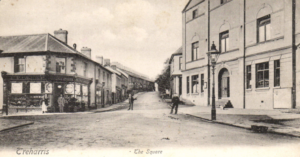

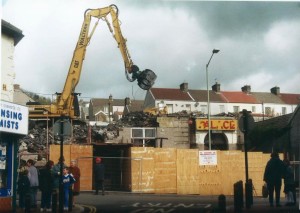







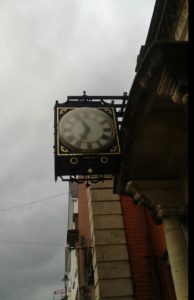

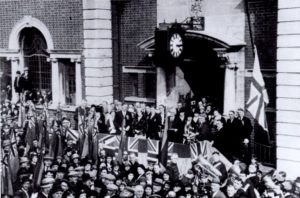
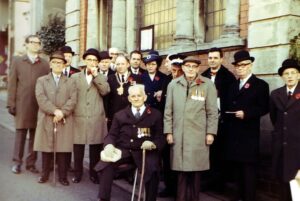

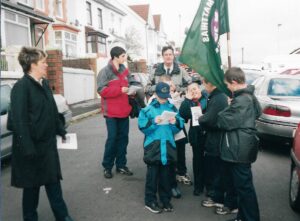
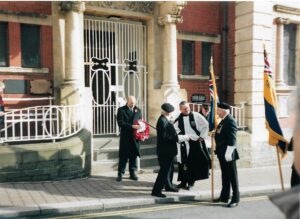
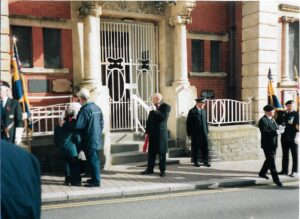
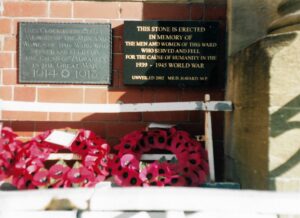

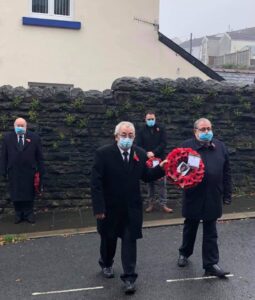
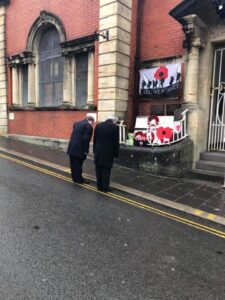






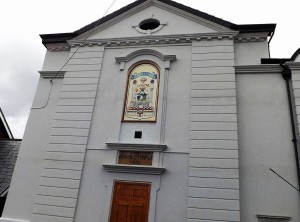



The demolition of the Palace Cinema commenced on the 25th of January 2000. The site has been acquired by the Merthyr Tydfil Housing Association who are proposing to construct flats on the site. That was later discounted a green area was put there before further redevelopment in 2013.